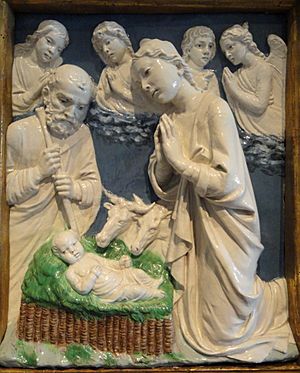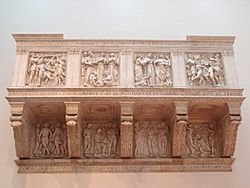Luca della Robbia facts for kids

Luca della Robbia (born 1399 or 1400, died 1482) was a famous Italian Renaissance sculptor from Florence, Italy. He is best known for creating colorful statues and artworks made from tin-glazed terracotta. This was a special technique he invented.
Luca della Robbia taught this unique method to his nephew Andrea della Robbia and his great-nephews Giovanni della Robbia and Girolamo della Robbia. While he was a skilled sculptor in stone, he mostly worked with terracotta after developing his new technique in the 1440s. His large workshop made many pieces, some from molds and others as unique, handmade artworks.
The bright, colorful glazes made his art strong and very expressive. His work is known for its gentle charm, not the dramatic style of some other artists of his time. Two of his famous pieces are The Nativity (around 1460) and Madonna and Child (around 1475). His most famous stone artwork is the Cantoria (singing loft) in the Florence Cathedral, which he made from 1431 to 1438. This was his first big project.
A famous writer named Leon Battista Alberti praised Luca della Robbia. He said Luca was as brilliant as other great artists like Donatello, Lorenzo Ghiberti, Filippo Brunelleschi, and Masaccio. This shows how important Luca's work in marble, bronze, and terracotta was during his time.
Biography of Luca della Robbia
Luca della Robbia was born in Florence. His father was a member of the wool-workers' guild called the Arte della Lana. Some early writers say he might have first trained as a goldsmith. He may also have worked with Lorenzo Ghiberti on the famous bronze doors of the Florence Baptistry.
Luca was greatly influenced by the sculptor Donatello. In the 1420s, the architect Filippo Brunelleschi hired Luca to create sculptures for his buildings. Luca received an important job to create the Cantoria (Singing Gallery) for the Florence Cathedral. This was from 1431 to 1438. He joined the sculptors' guild in 1432. It is believed that the powerful Medici family helped him get this important job.
Luca's Stone Sculptures
Luca della Robbia's first big project was the Cantoria (Singing Gallery) for the Florence Cathedral. He worked on this from 1431 to 1438. During the seven years he carved the reliefs, his style changed and improved. The first panels he carved were quite balanced and still. But in later panels, the singers look much more active and lively.
The Singing Gallery shows children singing, dancing, and playing music. They are praising the Lord, as described in Psalm 150. The figures are full of life and very detailed. They are also gracefully arranged in groups within the ten panels of the gallery. This work showed Luca della Robbia's great skill in stone. It also proved he was a major artist in Florence and a master of the Renaissance style.
Over the next twenty years, Luca made other important works in marble and bronze. These include small marble reliefs for the bell tower of the Florence Cathedral (1437). He also made a marble and enameled terracotta tabernacle (1443). He worked with another artist, Michelozzo, on large bronze doors for the Sacristy of the Cathedral. These doors were finished in 1469. They have a few figures placed simply against a flat background. This is different from the more detailed and busy doors made by Lorenzo Ghiberti.
One of Luca's most important marble works is the tomb of Benozzo Federighi. He was a bishop of Fiesole. Luca made this tomb between 1454 and 1456. The tomb shows the bishop resting peacefully. The sarcophagus below has beautiful carvings of angels. Above the bishop are figures of Christ, St John, and the Virgin Mary. The whole tomb is surrounded by a frame of painted tiles. Each tile has bright, realistic flowers and fruit painted with enamel colors.
Luca's Terracotta Art

Luca della Robbia's earliest surviving freestanding sculpture is the white tin-glazed terracotta Visitation. It is in the church of San Giovanni Fuoricivitas in Pistoia and dates to 1445. We don't know exactly when Luca started using colored glazed terracotta. But his skill with this material led to two big jobs for the Florence Cathedral. These were large reliefs of the Resurrection (also 1445) and the Ascension of Christ (1446).
The soft clay, covered with a shiny glaze, created a smooth, polished surface. This surface could reflect light and color beautifully. It was perfect for sculptures used in buildings. Luca della Robbia's reliefs in this material were masterpieces. They brought life to the large, serious space of the Cathedral. He also made a series of Twelve Apostles for the small Pazzi Chapel (1443–1450) in Florence.
Luca worked with helpers, including his family members. He created many decorative reliefs and altarpieces throughout his life. A beautiful example is the enameled terracotta ceiling (1466) of the Chapel of the Cardinal of Portugal in San Miniato, Florence. Another artwork, now in the Victoria and Albert Museum, shows his amazing use of color. It is a huge round medallion with the coat of arms of René of Anjou. It is surrounded by a detailed wreath of brightly colored fruit and flowers. These include apples, lemons, oranges, and fir cones. This medallion was placed on the front of the Pazzi Palace to remember René's visit to Florence in 1442.
Luca's artworks were very popular during his time. Many were sent outside Florence. The larger pieces could be taken apart to make them easier to transport. In 1446, he bought a large house with a workshop. This workshop remained the family's base until the 1520s.
In 1471, Luca della Robbia was chosen to be the president of the Florentine Guild of Sculptors. However, he declined because he was old and unwell. This shows how highly his fellow artists respected him. He passed away in Florence in February 1482. He took many of his secrets for making tin-based glazes with him.
See also
 In Spanish: Luca della Robbia para niños
In Spanish: Luca della Robbia para niños



